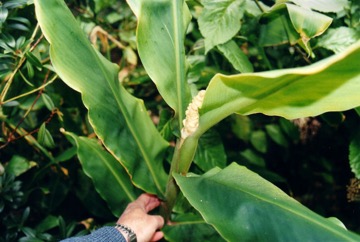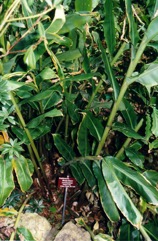Butterfly ginger, White ginger lily

A tropical plant. It suits moist and dry seasonal climates. It needs fertile, humus-rich, well-drained soil. It needs morning sun or bright shade. It grows in forests and is also cultivated in S China. It grows up to 2,500 m above sea level. It is used on the Deccan in India. In Argentina it grows from sea level to 1,200 m above sea level. In Hobart Botanical gardens. It suits hardiness zones 7-12. In Sichuan and Yunnan.
Also known as:
A ci a ye, Banay, Bottlebrush ginger, Bunga bet, Butterfly flower, Daihenghao, Gandasuli, Garland flower, Ginger Lily, Gondasuli, Hun kaeo, Jiang hua, Kamia, Karankaa, Katkatan, Lok-lei, Loklei, Maha-hongse, Mahaahong, Mandasuli, Mir tado akelok, Ngwe-pan, Shekra bu, Sinser, Suli, Takhellei, Tha haan, Thahern, Tunun, White ginger
Synonyms
- Amomum filiforme Hunter ex Ridl.
- Hedychium chrysoleucum Hook.
- Hedychium coronarium var. baimao Z.Y.Zhu
- amd others
Edible Portion
- Flowers - flavouring, Tubers, Rhizomes, Root, Shoots
Where does Butterfly ginger grow?
Found in: Africa, Andamans, Argentina, Asia, Australia, Bangladesh, Belize, Bhutan, Brazil, Caribbean, Central America, China, Costa Rica, Ecuador, Eswatini, Fiji, Guiana, Guianas, Guyana, Hawaii, Himalayas, Honduras, India, Indochina, Indonesia, Jamaica, Korea, Laos, Madagascar, Malaysia, Maldives, Mariana Islands, Marquesas, Mauritius, Micronesia, Myanmar, Nauru, Nepal, New Zealand, North America, Northeastern India, Pacific, Palau, Papua New Guinea, PNG, Paraguay, Philippines, Puerto Rico, Reunion, Rotuma, Sao Tome and Principe, SE Asia, Sierra Leone, Sikkim, Singapore, South Africa, South America, Southern Africa, Sri Lanka, St Helena, St Lucia, Suriname, Swaziland, Taiwan, Tasmania, Thailand, Tonga, United States, Venezuela, Vietnam, Wallis & Futuna, West Africa
Notes: There are about 50 Hedychium species. It is also grown as an ornamental and for medicine. It can be invasive.
Status: The rhizomes are sold in markets. The plant has been introduced to Papua New Guinea. It is similar to Gorgor.
Growing Butterfly ginger, White ginger lily
Cultivation: Plants can be grown from seeds, offsets or division of the rhizome.
Edible Uses: The young rhizomes and soft shoots are cooked and eaten as a vegetable. They are blanched and served with chili sauce. The flowers are cooked and eaten as a vegetable. They are usually stewed or stir fried.
Nutrition Info
per 100g edible portion| Edible Part | Energy (kcal) | Protein (g) | Iron (mg) | Vitamin A (ug) | Vitamin c (mg) | Zinc (mg) | % Water |
|---|---|---|---|---|---|---|---|
| - | - | - | - | - | - |
Butterfly ginger, White ginger lily Photos


References
Alimenticias - FloraSBS
Ambasta, S.P. (Ed.), 2000, The Useful Plants of India. CSIR India. p 257
Brickell, C. (Ed.), 1999, The Royal Horticultural Society A-Z Encyclopedia of Garden Plants. Convent Garden Books. p 500
Burkill, H. M., 1985, The useful plants of west tropical Africa, Vol. 3. Kew.
Burkill, I.H., 1966, A Dictionary of the Economic Products of the Malay Peninsula. Ministry of Agriculture and Cooperatives, Kuala Lumpur, Malaysia. Vol 1 (A-H) p 1146
Chen, I., et al, 2008, Antioxidant and Antimicrobial Activities of Zingiberaceae Plants in Taiwan. Plant Foods for Human Nutritition, 63:15-20
Cundall, P., (ed.), 2004, Gardening Australia: flora: the gardener's bible. ABC Books. p 680
Devi, O.S., P. Komor & D. Das, 2010, A checklist of traditional edible bio-resources from Ima markets of Imphal Valley, Manipur, India. Journal of Threatened Taxa 2(11): 1291-1296
Facciola, S., 1998, Cornucopia 2: a Source Book of Edible Plants. Kampong Publications, p 248
Fu, Yongneng, et al, 2003, Relocating Plants from Swidden Fallows to Gardens in Southwestern China. Economic Botany, 57(3): 389-402
Hu, Shiu-ying, 2005, Food Plants of China. The Chinese University Press. p 328
Jacquat, C., 1990, Plants from the Markets of Thailand. D.K. Book House p 117
Jain et al, 2011, Dietary Use and Conservation Concern of Edible Wetland Plants at Indo-Burma Hotspot: A Case Study from Northeast India. Journal of Ethnobiology and Ethnomedicine 7:29 p 6
Konsam, S., et al, 2016, Assessment of wild leafy vegetables traditionally consumed by the ethnic communities of Manipur, northeast India. Journal of Ethnobiology and Ethnomedicine, 12:9
Kunkel,
Lamoureux, C.H., 1976, Trailside Plants of Hawaii's National Parks. Hawaii Natural History Association. p 22
Larsen, K., Ibrahim, H., Khaw, S.H., & Saw, L.G., 1999, Gingers of Peninsula Malaysia and Singapore. Natural History Publications (Borneo). p 50
Lavelle, M., 2008, Wild Flowers of Australia and Oceania. Southwater. p 109
Lembaga Biologi Nasional, 1977, Ubi-Ubian, Balai Pustaka, Jakarta. p 28
Lim, T. K., 2015, Edible Medicinal and Non Medicinal Plants. Volume 9, Modified Stems, Roots, Bulbs. Springer p 45
Lim, T. K., 2016, Edible Medicinal and Non-Medicinal Plants: Volume 12 Modified Stems, Roots p 7
Liu, Yi-tao, & Long, Chun-Lin, 2002, Studies on Edible Flowers Consumed by Ethnic Groups in Yunnan. Acta Botanica Yunnanica. 24(1):41-56
Liu, Yi-tao, & Long, Chun-Lin, 2002, Studies on Edible Flowers Consumed by Ethnic Groups in Yunnan. Acta Botanica Yunnanica. 24(1):41-56 (Also as Hedychium chrysoleucum)
Llamas, K.A., 2003, Tropical Flowering Plants. Timber Press. p 369
Luo, B., et al, 2019, Wild edible plants collected by Hani from terraced rice paddy agroecosystem in Honghe Prefecture, Yunnan, China. Journal of Ethnobiology and Ethnomedicine 15:56
Marinelli, J. (Ed), 2004, Plant. DK. p 456
Misra, R. C., et al, 2013, Genetic resources of wild tuberous food plants traditionally used in Similipal Biosphere Reserve, Odisha, India. Genetic Resources and Crop Evolution. Vol. 60 No. 2. Springer
Peekel, P.G., 1984, (Translation E.E.Henty), Flora of the Bismarck Archipelago for Naturalists, Division of Botany, Lae, PNG. p 107, 108
Pfoze, N. L., et al, 2012, Survey and assessment of floral diversity on wild edible plants from Senapati district of Manipur, Northeast India. Journal or Biodiversity and Environmental Sciences. 1(6):50-52
Priyadi, H., et al, 2010, Five hundred plant species in Gunung Halimun Salak National Park West Java. A checklist including Sundanese names, distribution and use. CIFOR, FFPRI, SLU p 34
PROSEA handbook Volume 9 Plants yielding non-seed carbohydrates. p 188
Recher, P, 2001, Fruit Spirit Botanical Gardens Plant Index. www.nrg.com.au/~recher/ seedlist.html p 4
Retzius, Observ. Bot. 3:73. 1783
Seidemann J., 2005, World Spice Plants. Economic Usage, Botany, Taxonomy. Springer. p 173
Singh, P.K., Singh, N.I., and Singh, L.J., 1988, Ethnobotanical Studies on Wild Edible Plants in the Markets of Manipur - 2. J. Econ. Tax. Bot. Vol. 12 No. 1 pp 113-119
Singh, P.K., Singh, N.I., and Singh, L.J., 1988, Ethnobotanical Studies on Wild Edible Plants in the Markets of Manipur - 2. J. Econ. Tax. Bot. Vol. 12 No. 1 pp 113-119 (Also as Hedychium coronarium var. chrysoleucum)
Sirirugsa, P., 1999, Thai Zingiberaceae: Species Diversity and their Uses. http://www.iupac.org/symposia/proceedings/phuket 97
Smith, A.C., 1979, Flora Vitiensis Nova, Lawaii, Kuai, Hawaii, Volume 1 p 197
Staples, G.W. and Herbst, D.R., 2005, A tropical Garden Flora. Bishop Museum Press, Honolulu, Hawaii. p 765
Sujanapal, P., & Sankaran, K. V., 2016, Common Plants of Maldives. FAO & Kerala FRI, p 142
Sukarya, D. G., (Ed.) 2013, 3,500 Plant Species of the Botanic Gardens of Indonesia. LIPI p 1111
Swaziland's Flora Database http://www.sntc.org.sz/flora
Tanaka,
Teron, R. & Borthakur, S. K., 2016, Edible Medicines: An Exploration of Medicinal Plants in Dietary Practices of Karbi Tribal Population of Assam, Northeast India. In Mondal, N. & Sen, J.(Ed.) Nutrition and Health among tribal populations of India. p 157
WATT,
World Checklist of Useful Plant Species 2020. Royal Botanic Gardens, Kew
Wu Delin, Larsen, K., Zingiberaceae. Flora of China.
Xu, You-Kai, et al, 2004, Wild Vegetable Resources and Market Survey in Xishuangbanna, Southwest China. Economic Botany. 58(4): 647-667.
Xu, You-Kai, et al, 2004, Wild Vegetable Resources and Market Survey in Xishuangbanna, Southwest China. Economic Botany. 58(4): 647-667. (Also as Hedychium chrysoleucum)
Yuncker, T.G., 1959, Plants of Tonga, Bernice P. Bishop Museum, Hawaii, Bulletin 220. p 85
Zuchowski W., 2007, Tropical Plants of Costa Rica. A Zona Tropical Publication, Comstock Publishing. p 157